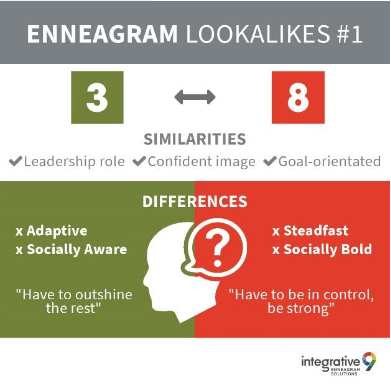The Enneagram is a framework that points to nine different ways of looking at the world. It refers to nine different Types, each representing the way certain individuals think, feel and act. It is more than a personality profile, as it delves deeper into the often-unconscious core motivations that lie deep in our personality, to help us to understand why we are the way we are.
While each of us has all nine motivations within us to a greater or lesser degree, one of the nine is more dominant and serves as the main driver for how we show up in the world.
Some individuals find it much easier to find themselves on the Enneagram and recognise their Type at first glance, where others may take a while longer and need guidance as they explore. Why is this? This is often due to the fact that the structure of the Enneagram goes beyond the level of visible behaviour. Instead, it is built from core motivations and fears which are more unconscious elements of personality and sometimes cannot be objectively observed.
This means that there are certain Types and Subtypes within the Enneagram that display some similar behaviours that are often referred to as lookalikes. Through our extensive research into typing and lookalikes at Integrative Enneagram Solutions, we find that these lookalikes are often more common with particular Subtypes, especially counter-types, which tend to display behaviours that are more difficult to recognise as ‘true to Type’ at a superficial level.

For example, the assertive Type 3 and Type 8 are lookalikes and are sometimes mistyped as each other, especially the social (SO) 3 Subtype with either the self-preservation (SP) 8 or one-on-one/sexual (SX) 8 Subtypes.
Similarities: Both Threes and Eights tend to thrive in corporate hierarchies and competitive arenas, and both often take on leadership or management roles. Both present a confident image and are comfortable taking risks and standing out. Often impatient or fast-paced, Threes and Eights can seem unstoppable in pursuit of their goals. Neither the Enneagram Three nor Eight are comfortable accessing their own feelings and vulnerability, making them tough and stoic.
Differentiators: However, when they encounter obstacles to achieving those goals, Threes are likely to change gear or tactics to get around them, where Eights tend to ‘dig in’ and hold their track, preferring to push through. Socially, Threes are inclined to be smoother and more appropriate than Eights, who may behave crudely or break the rules to prove their independence and shock others.
This is just one example of the Enneagram combinations Integrative Enneagram Solutions tracks and researches, and our training offerings help practitioners develop the skills to differentiate between these pairs.
Exploring Lookalikes – Looking Under the Surface
While the Enneagram lookalikes may share certain surface or behavioural-level similarities, it is important to remember that Enneagram Type is determined by deeper motivational drivers. These lookalikes always have key differentiators when you consider less visible levels of drivers and motivation. Therefore, once an individual digs deeper into their experience, they may discover their true Type and find that their behaviour is simply an ‘overlay’ or learned behaviour pattern.To aid individuals in finding their true Enneagram Type and to address the challenges that come with behavioural lookalikes, the iEQ9 questionnaire items are not behaviourally based but tap into underlying motivation. Harnessing the power of technology to dynamically change questionnaire items based on an individual’s responses, our assessment also tests between lookalike pairs with targeted and highly specified mistyping questions.
Integrative Enneagram Solutions also trains all our accredited practitioners in a deep understanding of the various Enneagram Types, Subtypes, their nuances as well as psychodynamics, to ensure that our practitioners can support a considered reflection on Type and guide clients to discover themselves on the Enneagram framework.
Exploring and understanding the lookalikes on the Enneagram can help clients clarify and find their true point of resonance, but also develop an appreciation of the subtleties, similarities and differences between them and others. Rather than a race to ‘find the right type’, the possibility of a lookalike or a mistype can be the beginning of a journey of exploration and self-discovery.
Confused? Get your type with the most accurate Enneagram online questionnaire. Get your iEQ9 Enneagram Test

 What is the Enneagram?
What is the Enneagram?
 Introduction to the 27 Subtypes
Introduction to the 27 Subtypes
 Introduction to the 3 Centers
Introduction to the 3 Centers
 Wings
Wings
 Lines and Integration
Lines and Integration
 Enneagram History & Origin
Enneagram History & Origin
 Enneagram for Myself
Enneagram for Myself
 Enneagram for Practitioners
Enneagram for Practitioners
 Enneagram for Business
Enneagram for Business
 iEQ9 Individual Reports
iEQ9 Individual Reports
 iEQ9 Team Reports
iEQ9 Team Reports
 iEQ9 Questionnaire
iEQ9 Questionnaire
 Training Events
Training Events
 Level 1 iEQ9 Accreditation
Level 1 iEQ9 Accreditation
 Level 2 Enneagram Team Dynamics
Level 2 Enneagram Team Dynamics
 International Enneagram Conference
International Enneagram Conference
 iEQ9 Community of Practice Events
iEQ9 Community of Practice Events
 About Integrative9
About Integrative9
 Meet the Faculty
Meet the Faculty
 Testimonials
Testimonials
 Contact Us
Contact Us



